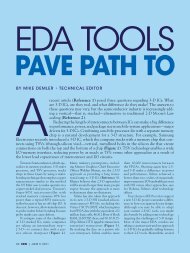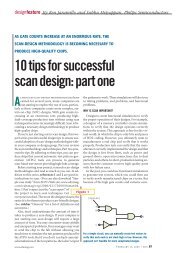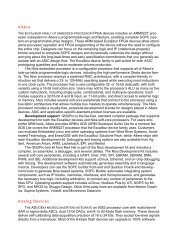designfeature DSP assembly language - EDN
designfeature DSP assembly language - EDN
designfeature DSP assembly language - EDN
You also want an ePaper? Increase the reach of your titles
YUMPU automatically turns print PDFs into web optimized ePapers that Google loves.
<strong>designfeature</strong> <strong>DSP</strong> <strong>assembly</strong> <strong>language</strong><br />
gest themselves as logical candidates for<br />
coding in <strong>assembly</strong>. In digital-communication<br />
applications, FIR or IIR filters lend<br />
themselves well to C with intrinsic functions,<br />
but you still need to program Viterbi<br />
or Reed-Solomon decoders in <strong>assembly</strong>,<br />
according to Kevin Stone, product<br />
engineer at ZSP Corp.<br />
<strong>DSP</strong> ARCHITECTURES INFLUENCE CODE<br />
Detailed knowledge of the target architecture<br />
is a must for developing efficient<br />
application code, especially knowing<br />
which “dirty tricks” you can use to<br />
take advantage of the architecture’s<br />
strengths. Programming <strong>DSP</strong>s becomes<br />
easy when the architecture and programming<br />
model of a <strong>DSP</strong> are wellstructured.<br />
For example, a <strong>DSP</strong> that has<br />
a very orthogonal instruction set (that is,<br />
all commands work on all registers) is<br />
easier to program and optimize than a<br />
<strong>DSP</strong> whose commands work only on specific<br />
ALU registers. For example, Analog<br />
Devices’A<strong>DSP</strong>-21062 Super Harvard Architecture<br />
Computer (SHARC) <strong>DSP</strong> features<br />
three independent parallel computation<br />
units: the ALU, the multiplier, and<br />
the shifter. Single multifunction instructions<br />
execute parallel ALU and multiplier<br />
operations.<br />
The <strong>DSP</strong> features an enhanced Harvard<br />
architecture in which the datamemory<br />
bus transfers data and the program-memory<br />
bus transfers both<br />
instructions and data. A general-purpose,<br />
10-port, 32-bit data-register file, combined<br />
with the A<strong>DSP</strong>-<br />
21000 Harvard architec-<br />
ture, allows unrestricted<br />
data flow between<br />
computation units<br />
and internal memory. The<br />
A<strong>DSP</strong>-21062 includes an<br />
on-chip instruction cache<br />
that enables three-bus operation<br />
for fetching an instruction<br />
and two data values.<br />
The cache selectively<br />
caches only those instructions<br />
whose fetch operations<br />
conflict with program-memory-bus<br />
data<br />
accesses.<br />
This scheme allows fast<br />
execution of core, looped<br />
operations, such as multiply-accumulate<br />
(MAC) instructions<br />
and FFT butterfly<br />
processing. The device’s<br />
Figure 1<br />
AT A GLANCE<br />
3Programming <strong>DSP</strong>s in mnemonics or<br />
algebraic <strong>assembly</strong> <strong>language</strong> is a necessity<br />
because no better way exists to generate<br />
compact code and ensure faster execution<br />
of application software.<br />
3Depending on the application and timeto-market<br />
considerations, you have to<br />
proceed carefully with your <strong>DSP</strong> application<br />
development.<br />
3Now, rather than develop <strong>assembly</strong><strong>language</strong><br />
modules from the ground up, you<br />
can use a C compiler to generate <strong>assembly</strong><br />
code.<br />
3You can further optimize and debug the<br />
C compiler-generated <strong>assembly</strong> code by<br />
using development tools supplied by <strong>DSP</strong><br />
vendors and third-party developers.<br />
48-bit instruction word accommodates a<br />
variety of parallel operations for concise<br />
coding. For example, the A<strong>DSP</strong>-21062<br />
can execute a multiply, an add, a subtract,<br />
and a branch all in a single instruction.<br />
ZSP Corp’s ZSP16401 is a 16-bit fixedpoint<br />
<strong>DSP</strong> based on a superscalar architecture<br />
(register-based with multiple execution<br />
units) that employs a five-stage<br />
pipeline. The <strong>DSP</strong> features two ALUs and<br />
two MAC units, which use a 16-bit register-operand<br />
file for their source and<br />
The integrated development environment debugger window of the ZSP164xx<br />
<strong>DSP</strong> lets you quickly complete code debugging. ZSP’s Profiler (also known<br />
as Simulator) gives you valuable information about how the instructions are<br />
grouped so that you can optimize the code and thus achieve maximum<br />
performance.<br />
destination. This register-rich architecture<br />
avoids accumulator bottlenecks and<br />
helps reduce immediate memory accesses.<br />
Further, you can use data memory as<br />
a general-purpose, scratchpad resource<br />
while reading and writing to device registers.<br />
There are no restrictions on reading<br />
and writing to data memory, unlike<br />
the segregated read and read/write memory<br />
scheme found in traditional <strong>DSP</strong>s.<br />
Code development for the device has<br />
the look and feel of development for a �C<br />
<strong>assembly</strong> code (Figure 1). For example,<br />
you can write <strong>assembly</strong>-<strong>language</strong> routines<br />
as a linear sequence of instructions.<br />
You can also combine instructions that<br />
specify one or two operations with other<br />
instructions for parallel execution, but<br />
the code contains no scheduling information.<br />
Thanks to the device’s pipelinecontrol<br />
unit, which schedules as many as<br />
four instructions for execution within the<br />
same clock cycle, you need not worry<br />
about scheduling parallel execution. This<br />
feature is a major benefit, because it allows<br />
you to concentrate on the algorithm<br />
and its implementation rather than on<br />
the <strong>DSP</strong>’s architecture.<br />
THE SKILL FACTOR<br />
The inherent nature of <strong>DSP</strong> applications<br />
means that certain programming<br />
skills are unique to <strong>DSP</strong>-<strong>assembly</strong> programming.<br />
Coding <strong>DSP</strong> algorithms is<br />
mathematically intensive. Mapping those<br />
models onto a <strong>DSP</strong>’s architecture is a skill<br />
unique to <strong>DSP</strong> <strong>assembly</strong> programmers.<br />
“You often trade off when<br />
coding an algorithm that requires<br />
41 MIPS onto an architecture<br />
that can deliver<br />
only 40 MIPS,” says Analog<br />
Devices’ Kafka.“In such situations,<br />
a thorough understanding<br />
of the math involved<br />
in the algorithm will<br />
help the <strong>assembly</strong> programmer<br />
modify the algorithm so<br />
that it requires fewer MIPS<br />
while still delivering the desired<br />
results.”<br />
According to Kafka, <strong>DSP</strong><strong>assembly</strong><br />
programming also<br />
requires that you understand<br />
instruction stalls. Instruction<br />
stalling is important because<br />
it helps you optimize <strong>assembly</strong>.<br />
“Stalling” means that a<br />
previous instruction delays<br />
the next instruction because<br />
104 edn | January 21, 1999 www.ednmag.com









